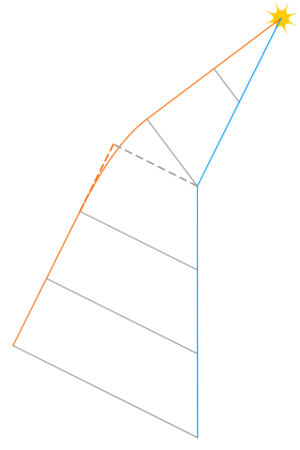IR Pattern -- G
Range
AIM-9B has both minimum and maximum range restrictions. Basic minimum range for launching is 3,000 feet. This is determined by three factors: (1) Time for the influence fuze to arm, (2) Time for the missile to set up a collision course, and (3) Delta Mach. To be assured of a kill, all three of these factors must be considered. First, time for the influence fuze to arm: It has been proven through empirical testing, that approximately 85% of the kills achieved have been through influence fuze action. Since it takes the influence fuze about two seconds to arm – at rocket motor burn-out – a minimum range must be considered. Second, time for the missile to set up a collision course: After launching, the missile does not begin to guide until it clears the launch aircraft. This delay lasts for about 1 ∕ 2 second, at the end of which time the missile receives its first guidance command and starts to set up a collision course. Third, Delta Mach (rate of closure): At rocket motor burn-out, the missile is traveling about 1.7 Mach above the speed of the launch aircraft. If the launch aircraft has a high rate of closure, the missile has a faster airspeed relative to the target. Since it takes a definite time for the influence fuze to arm, and a definite time for the missile to set up a collision course, the missile must travel a greater distance, relative to the target, before either one of these occurs. Missile firing range can be determined by use of the following formula: Minimum range is equal to 3000 ± (Delta Mach × 3000).
To illustrate : If the launch aircraft is traveling at 1.2 Mach and the target aircraft at .8 Mach, we have a Delta Mach of .4. Applying this to the formula, we see that minimum range is equal to 3000 + (.4 × 3000), or 4200 feet.
The general “rule-of-thumb” for minimum range, co-airspeed, co-altitude, however, is 3000 feet. Maximum Range: Maximum range is determined by three factors – guidance time, air density, and Delta Mach. Missile guidance time is approximately 18 seconds, which is a constant value applied to both air density and Delta Mach. Air density is important factor, in that the higher the air density the greater the aerodynamic drag, thus the shorter the range over an 18-second time period. Delta Mach is important in that the faster the launch aircraft, the faster the missile in relation to the target; thus, over an 18-second time period, the greater the distance the missile will travel. Many max-range charts have been develop by both the Air Force and the Navy to depict the maximum range at various altitudes, airspeeds, and Delta Mach relationships; however, it is virtually impossible to remember all these relationships.
The following “rules-of-thumb” may be used by the pilot to determine max range:
(1) For co-speed attacks against trans-sonic bombers – one mile for altitudes below 10,000 feet, add one-half mile range for each additional 10,000 feet increase in altitude.
(2) For co-speed attacks against supersonic targets – one mile range for altitudes below 20,000 feet and add one-half mile for each additional 10,000-foot increase in altitude. In applying the rules-of-thumb we can see that Sidewinder’s max-effective range against a sub-sonic target at 30,000 feet would be two miles, or, roughly 10,000 feet slant range. Against a supersonic target at 30,000 feet, the maximum slant range would be approximately one and one-half mile, or, roughly 7800 feet.
(3) Delta Mach “rule-of-thumb”: Add one thousand feet for each .1 Delta Mach when above 30,000 feet altitude. To illustrate: A .8 Mach target, at 30,000 feet, is being attacked by a 1.2-Mach fighter at the same altitude. Applying the sub-sonic rule-of-thumb, we find that the max-effective range at which we can launch the missile is 10,000 feet, or approximately 2 miles, for a co-speed condition. Adding 4000 feet for .4 Delta Mach, we compute a new max-effective range of 14,000 feet. The only problem now is range estimation. When in the cockpit of an attacking fighter, at minimum ranges, there is no problem, since we may use the ASG-17 radar to determine range. At max range, however, we are beyond the capability of the radar and must use another means of determining our approximate range from a given target. For normal missile firing ranges, fairly accurate range estimation can be accomplished by comparing a known aircraft wingspan with the sight reticle radius, or with pipper diameter. Applying the formula,
X = WS x 1000 / S
Where
X = size of the target in mils
WS = wingspan of the target in feet
S = range of the attacking fighter from the target
we can determine the size of the target, in relation to the 70-mil-diameter reticle or 2-mil pipper.
Example 1:
Size of Badger (wingspan 116’) in mils when range is 10,000’
X = 116 x 1000 / 10,000 = 11.6 or approximately 12 mils
This means that at 10,000 feet, the Badger wingspan will subtend 1 ∕ 3 of reticle radius (35 mils). At 20,000 feet the Badger span will be 6 mils and will subtend 3 pipper widths. At 5,000 feet the Badger span will be 23 mils and will subtend 2 ∕ 3 of a reticle radius.
Example 2:
Size of F-100 (wingspan 39’) in mils when range is 10,000 feet
X = 39 x 1000 / 10,000 = 3.9 or approximately 4 mils
At 10,000 feet the F-100 wingspan will subtend 2 pipper widths. At 20,000 feet it will subtend 1 pipper width, and at 5000 feet, 4 pipper widths or approximately 1 ∕ 5 of radius.
IR Pattern -- G
